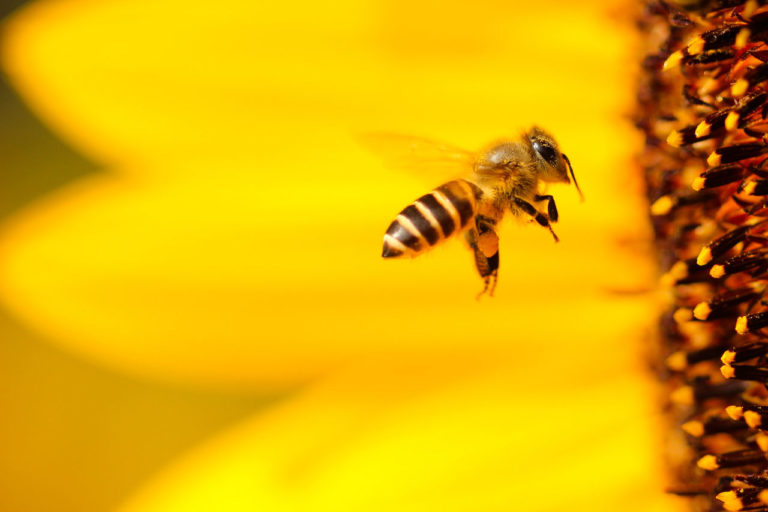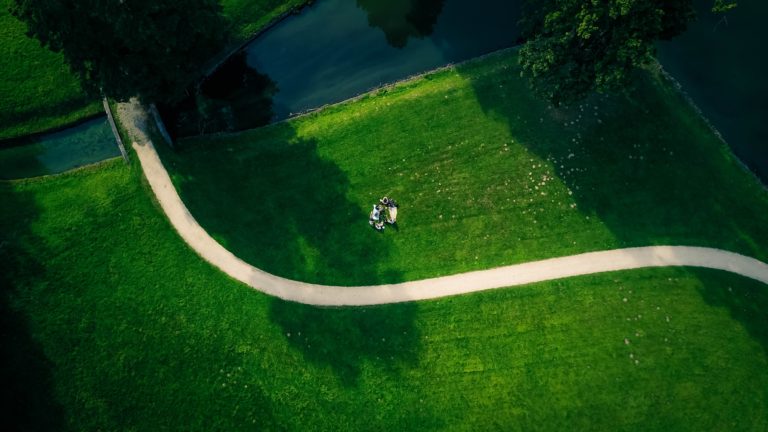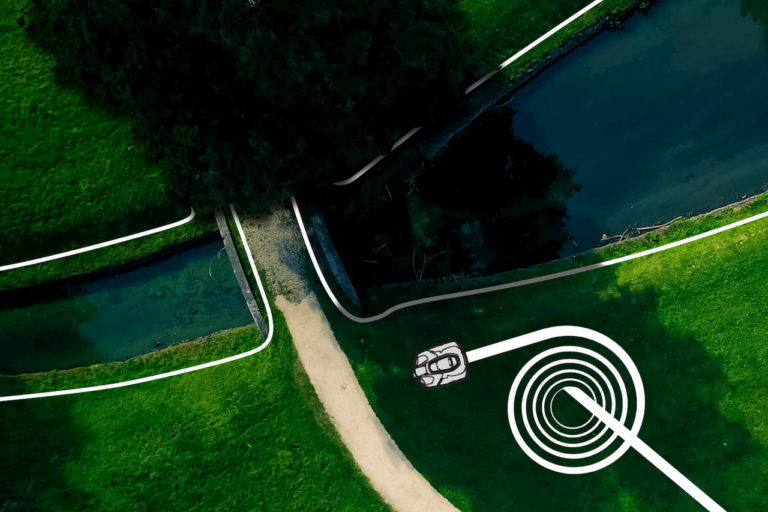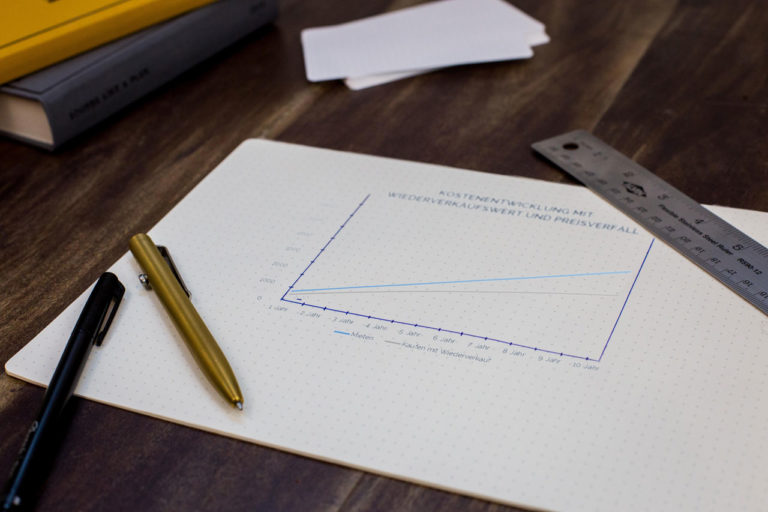If you are dealing with robotic mowers for the first time, you are probably wondering what actually happens to the grass that is trimmed off. Does the robotic mower collect it somehow? Or do you have to collect it yourself? How does the whole thing work? Here you can find out exactly how the robotic mower operates when mowing the lawn.
What does the robotic mower do with the grass clippings? A robotic mower mows the lawn according to the mulching principle. The mower cuts off only the uppermost tip of the grass, resulting in very small clippings, also known as lawn mulch, which becomes weathered and decomposes over time. The nutrients released during this process can be utilized by the remaining grass to continue its growth.
But why does this work so well with the robotic mower? And why doesn’t every lawn mower just mow like that? What are the advantages and disadvantages of this system? I will explain this to you in the following paragraphs.
Contents
How does the robotic mower’s mowing system work?
The robotic mower does not mow the lawn like a normal lawn mower. The concept of the robotic mower is fundamentally different from that of a conventional lawnmower. In the case of the robotic mower, many clever functions more or less interlock, one of which would not work if the other were not there.
It is the same with the mulching system. The way the robotic mower mows the lawn is called mulch mowing. With a regular mower with a bag, the lawn is mowed once every week or two, with the clippings being collected and dumped on the compost heap or put out for trash collection. When mulch-mowing, however, the clippings remain on the lawn.
The grass clippings land on the lawn, where they slowly decompose and are converted into nutrients, which the lawn can then use again. This closes the nutrient cycle again.
The system is not new, special mulching mowers or lawn mowers with a mulching function have been available for some time. These not only cut the lawn, but also shred it again in an additional cutting unit located behind the actual mower. This is because the clippings must be small enough to easily decompose. Otherwise it can lead to various problems (more about this later).
The robotic mower does not have an extra cutting unit behind the mowing unit. Instead, it takes advantage of the fact that it can mow the lawn every day due to its autonomous mode of operation. It takes very little time for the robotic mower to cut the same area of lawn again after a cut. During this time the lawn grows only a very short amount, and the robotic mower then cuts off this small blade-tip. A very short grass clipping thus lands on the lawn, rots and becomes nutrients.
For this reason, the robotic mower does not need a collection bag or anything similar to what normal lawnmowers have, as all the cuttings are simply distributed back onto the lawn and converted into nutrients.
What are the advantages and disadvantages of the mulching system?
The mulching system of the robotic mower has some advantages, but also a few disadvantages, which I would like to enumerate here.
The advantages of the mulching system
- New nutrients are constantly available to the lawn
- Due to the the decomposition process, the nutrients are continuously released into the lawn
- This improves the lawn quality and density, with less moss and weeds
- Grass mulch near the roots helps store moisture in the soil, because the ground is better protected from the blazing sun
- Less light falling on the soil leads to reduced weed growth
- Less organic waste to dispose of. More space for other things in the compost bin
Disadvantages of the mulching system
- The grass must never be too high when mowed by the robotic mower, as long grass mulch causes problems. It decomposes badly, thus reducing the air permeability of the soil in the long term and leading to lawn thatching as well as rot and disease
- If the robotic mower does not mow for a longer period of time, due to adverse weather or required maintenance, the lawn cuttings must be collected. If the lawn has become very long, the first cut must be mowed with a normal lawn mower before the robotic mower can take over the work again
- Certain conditions may cause the lawn cuttings to not weather very well, such as low soil activity due to prolonged drought, or heavy waterlogging of the soil
- The very short lawn cut from daily mowing can easily be carried by children and pets into the house
The advantages in detail
Apart from the fact that mulch mowing enables the robotic mower to mow the lawn completely autonomously without the need to invent a technical solution to dispose of the clippings, mulch mowing offers a number of advantages for your lawn.
Probably the most important advantage is that the lawn quality is significantly improved by the constant supply of nutrients from grass clippings. Since lawn mulch is organic matter, it is decomposed by soil organisms and the nutrients are gradually released into the lawn. This allows the lawnmower to make better use of the nutrients than if the nutrients were available all in one go, as is the case with chemical fertilizers.
Imagine someone serving you a feast once a month and the rest of the month you must fast. Plants, too, can only absorb a limited amount of nutrients at once and can cope better with a continuous supply of nutrients than a large supply all at once.
The effects that result are that the lawn simply grows better and stronger, making it more difficult for intrusive plants such as weeds and wild grasses to settle on the lawn. The lawn also takes on a healthier color.
However, on many advice pages you will read that the robotic mower’s mulching system means that practically no fertilization of the lawn is necessary. Some manufacturers also advertise this, but it is not true. The lawn can do without a portion of the usual fertilizer, but it cannot do without fertilizer completely. You can read more about how you should fertilize a lawn when using a robotic mower here.
Another advantage of mulching is that the lawn cuttings distributed on the ground ensure that moisture is not extracted from the soil so quickly, especially in very strong sunlight. In the summer months, your lawn also benefits from mulching.
Weed growth is also more effectively contained, not only because the lawn grows stronger and asserts itself more effectively against other plants, but also because the soil is covered by the lawn mulch and therefore less light can reach the ground directly. This makes it more difficult for alien plants that spread through seeds to germinate.
In the end, you save waste from occupying the compost bin or trash can, because you no longer have any lawn waste. This leaves more space for other garden waste in the bin.
The disadvantages in detail
Probably the biggest disadvantage is that the lawn simply has to be mowed constantly. This is of course not a problem if your robotic mower takes over. Rarely will you see someone putting in the work to mulch-mow their lawn daily using a regular lawn mower.
The disadvantage is just that the robotic mower has to mow almost daily. There may be a maximum of one day between two mowing runs, and in periods of slow growth, two days off. If, for example, you go on vacation and you do not want to use the robotic mower during this time, you must first mow the lawn again with a normal mower when you return before the robotic mower can be used again.
So, for each longer interruption, you will have to mow the lawn by hand and collect the grass cuttings to avoid problems. If you don’t do this, or if you only let the robotic mower mow very rarely and therefore always have very long grass cuttings, the following problems can occur:
- Matting/thatching of the lawn
- Rotting of the lawn cut and the lawn
- Spread of fungi and other diseases
Not necessarily a disadvantage, but something that can partially cancel out the advantages of mulch mowing: Under certain circumstances, the grass clippings may not weather properly. Especially if the conditions for high soil activity are not right. If it is very dry for a long time, or if the soil has a lot of stagnant moisture, soil organisms cannot develop properly and thus the lawn cuttings cannot decompose.
However, this is either only a temporary problem (in summer, if you do not water your lawn), or can often be remedied by aeration, for example (in the case of waterlogging). Serious problems that cannot be solved only rarely occur here.
So as long as you use your robotic mower as intended, i.e. have it mow daily or every other day, you hardly have to deal with any disadvantages of the mulching system, and can benefit from all of its advantages.
Conclusion
The robotic mower mulches the lawn instead of mowing it like an ordinary lawnmower, simply because it can! It takes advantage of the fact that it can mow the lawn every day without your intervention, so the grass clippings are short enough to be used for mulching. There are many advantages for you and your lawn. However, the whole thing only works if the robotic mower mows the lawn regularly.
Related questions
Do robotic mowers work on uneven surfaces? Robotic mowers can generally cope with uneven lawns. How well they can do this depends on the model. Some models have very large wheels, which helps them navigate gradient changes. Dramatic unevenness should however be corrected if possible.
Also interesting: Robotic Mowers in Uneven Yards: What You Need to Know
Can the robotic mower be used on lawns with moss? The robotic mower generally has no problem with moss on the lawn. It is rather the other way round, that the regular use of a robotic mower can reduce the moss in the lawn. However, this is dependent on other factors, such as sufficient fertilization and watering of the lawn.





